Gurkha VCs
Gurkhas – Victoria Crosses (VCs)
Thirteen Victoria Crosses have been won by Gurkha regiments.Twenty-Six, Victoria Crosses have been won by Gurkha Regiments.
The Victoria Cross is the most honored and prestigious award for valor and heroism in the line of duty awarded by the British Government. Nepali Gurkhas have won thirteen Victoria Crosses, including countless other military awards. Below are extracts taken from some of these citations.
Gurkha VC holders with Queen Elizabeth II and Prince Philip For most conspicuous bravery during operations against the German Trenches south of Fauquissart, when himself wounded, on the 25 September 1915, he found a badly wounded soldier of the 2nd Leicestershire Regiment behind the first lone German trench, and through urged by the British soldier to save himself, he remained with him all day and night. In the early morning of the 26th September, in misty weather, he brought him out through the German wire, and leaving him in a place of comparative safety returned and brought in two wounded Gurkhas one after the other, He then went back in broad daylight for the British soldier at most points under the enemy’s fire.
Karna Bahadur Rana (Magar)
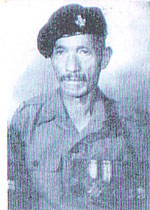 3rd Queen Alexandra’s
3rd Queen Alexandra’s
Own Gurkha Rifles
El. Kefr, Egypt
10 April 1918
On 10 April 1918 at El. Kefr, during an attack, Rifleman Karan Bahadur Rana and a few other men crept forward with a Lewis gun under intense fire to engage an enemy machine-gun. No. 1 of the Lewis gun team opened fire but was shot almost immediately, whereupon the rifleman pushed the dead man off the gun, opened fire, knocked out the enemy gun crew and then silenced the fire of the enemy bombers and riflemen in front of him. During the remainder of the day he did magnificent work and finally assisted with covering fire in the withdrawal, until the enemies were close on him.
Date and Place of Birth: 21 December 1898; V. Mangalthan, Gulmi, Nepal.
Son of Dalbir Rana
Enrolled: 21 December 1916
Subedar Lal Bahadur Thapa (Magar)
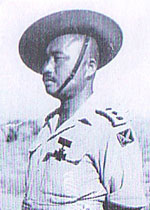 2nd King Edward VII’s Own Gurkha Rifles
2nd King Edward VII’s Own Gurkha Rifles
Resse-es- Zouai, Tunisia,
N. Africa April 1943
On the night of 5-6 April, during the silent attack on the Resse-es-Zouai, Subadar Lal Bahadur Thapa was Second-in-Command of D Company….
The garrison of the outer posts were all killed by Subadar Lal Bahadur Thapa and hi men by kukri or bayonet in the first rush and the enemy then opened very heavy fire straight down the narrow enclosed pathway and steep arena sides. Subadar Lalbahadur Thapa led his men on and fought his way up the narrow gully straight through the enemy’s fire, with little room to manoeuvre, in the face of intense and sustained machine-gun concentrations and the liberal us of grenades by the enemy.Next the machine-gun posts were dealt with, Subadar Lal Bahadur Thapa personally killing two men with his kukri and two more with his revolver. This Gurkha Officer continued to fight his way up the narrow bullet-swept approaches to thecrest. He and two riflemen managed to reach the crest, where Subadar Lal Bahadur Thapa then secured the whole feature and covered his company’s advance up the defile.
Havildar Gaje Ghale
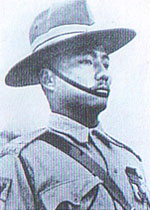 5th Royal Gurkha Rifles (FF)
5th Royal Gurkha Rifles (FF)
Chin Hills, Burma (Myanmar) May 1943
….while preparing for the attack the platoon came under heavy mortar fire but Havildar Gaje Ghale rallied them and led them forward.
Approaching to close range for the well-entranced enemy, then latoon came under withering fire and this NCO was wounded in the arm, chest and leg by an enemy hand grenade. Without pausing to attend to his serous wounds and with no heed to the intensive fire from sides, Havildar Gaje Ghale closed hi men and led them to close grips with the enemy when a bitter hand to hand struggle ensued.
Havildar Gaje Ghale dominated the fight by his outstanding example of dauntless courage and superb leadership. Hurling hand grenades, covered in blood from his own neglected wounds, he led assault after assault, encouraging his platoon by shouting the Gurkha’s battle cry. Spurred on by the irresistible will of their leader to win, the platoon stormed and carried the hill by a magnificent all out effort and inflicted very heavy casualties on the Japanese. Extract from London Gazette.
Rifleman Ganju Lama
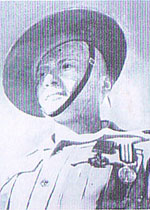 7th Gurkha Rifles
7th Gurkha Rifles
Ninthoukhong, Burma June 1944
B Company, 7th Gurkha Rifles, was ordered to counter-attack and restore the situation. Shortly after passing the starting line it came under heavy enemy medium machine-gun and tank machine-gun fire at point blank range, which covered all lines of approach. Rifleman Ganju Lama, the No.1 of the PIAT gun, on his own initiative, with great coolness and complete disregard for his own safety, crawled forward and engaged the tanks single handed. In spite of a broken left wrist and two other wounds, one in his right hand and one in his leg, caused by withering cross fire concentrated upon him, Rifleman Ganju Lama succeeded in bringing his gun into action within thirty yards of the enemy tanks and knocked out first one and then another, the third tank being destroyed by an anti-tank gun. In spite of his serous wounds, he then moved forward and engaged with grenades the tank crews, who now attempted to escape. Not until he hand killed them all, thus enabling his company to push forward, did he allow himself to be taken back to the Regimental Aid Post to have his wounds dressed.
Rifleman Tul Bahadur Pun
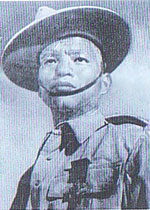 3rd Bn. 6th Gurkha Rifles
3rd Bn. 6th Gurkha Rifles
Moguang, Myanmar (Burma)
23 June 1944
Rifleman Tul Bahadur Pun then seized the Bren gun and firing from the hip as he went, continued the charge on this heavily bunkered positioned alone, in the face of the most shattering concentration of automatic fire, directed straight at him. With the dawn coming up behind him, he presented a perfect target to the Japanese. He had to move for thirty yards over open ground, ankle deep in mud, through shell holes and over fallen trees. Despite these overwhelming odds, he reached the Red House and close with the Japanese occupants. He killed three and put five more to flight and captured two light machine-guns remainder of his platoon which enabled them to reach their objective.
Rifleman (Acting Nak) Agam Singh Rai
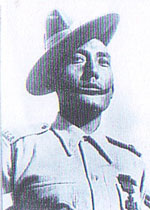 5th Royal Gurkha Rifles (FF)
5th Royal Gurkha Rifles (FF)
Bishenpur, Burma June 1944
This position was now under intense fire from the .37 millimeter gun in the jungle and from “Water Piquet” Naik Agam Sing Rai at once advanced towards the gun, his section without hesitation following their gallant leader. Intense fire reduced the section to three men before half the distance had before half the distance had been covered but they pressed on to their objective. Arriving at close range, naik Agam Singh Rai killed three of the crew and his men killed the other two. The pary then returned to “Mortar Bluff” where the rest of their platoon were forming up for the inal assault on “ Water Piquet” In the subsequent advance heavy machine-gun fire and showers of grenades from an isolated bunker position caused further causalities. Once more, with indomitable courage, Naik Agam Singh Rai, covered by his Bren gunner, advanced alone with a grenade in one hand and his Thompson sub-machine gun in the other. Through devastating fire he reached the enemy position and with his grenade and bursts from his Thompson sub-machine gun killed all four occupants of the bunker.
Subadar Netra Bahadur Thapa (Magar)
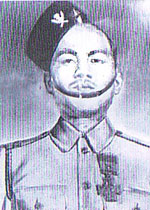 5th Gurkha Rifles in 2nd World War
5th Gurkha Rifles in 2nd World War
Bishenpur, Myanmar (Burma)
25-26 June 1944
On 25/26 June 1944 at Bishenpur, Subadar Netrabahadur Thapa was in command of a small isolated hill post, when the enemy attacked in force. The men, inspired by their leader’s fine example, held their ground and the enemies were beaten off, but casualties were very heavy and reinforcements were requested. When these arrived some hours later they too became casualties, but the subadar, undeterred, retrieved the ammunition himself and took the offensive with grenades and kukris, until he was killed.
Rifleman Thaman Gurung
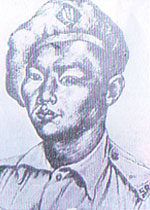 5th Royal Gurkha Rifles (FF)
5th Royal Gurkha Rifles (FF)
Monte San Bartolo
Italy, November 1944
By skillful stalking both scouts reached the position undetected… Releasing that if the enemy opened fire the section would sustain heavy casualties, Rifleman Thaman leapt to his feet and charged. The enemy completely taken by surprise surrendered with out opening fire.
He then crept to summits from which he saw a party of Germans well dug in of the reverse slopes… Rifleman Thaman crosses Ed the bare skyline firing his Tommy gun, thus allowing the forward section to reach the summit.
Soon afterwards, due to heavy enemy machine-gun fire, the fighting patrol was order to withdraw. Rifleman Thaman then again crossed the skyline-alone firing burst upon burst of Tommy gun fire until his ammunition ran out. Having thrown two grenades he rejoined his section, collection two more grenades and crossing the skyline for the third time hurled them at the remaining Germans.
The diversion enabled both rear sections to withdraw. Meanwhile the leading section was still on the summit, so Thaman seized a Bren gun, ran yet again to the skyline, emptied two magazines into the enemy position and then with the remaining section well in its way to safety turned to follow them, and at that very moment spun and fell with a bullet through his throat.
Rifleman Sher Bahadur Thapa (Chhettri)
9th Gurkha Rifles in 2nd world War
San Marino, Italy
18-19 September 1944
On 18 and 19 September 1944 at San Marino, Italy, when a company of the 9th Gurkha Rifles encountered bitter opposition from a German prepared position, Rifleman Sher Bahadur Thapa and his section commander, who was afterwards badly wounded, charged and silenced an enemy machine-gun. The rifleman then went on alone to the exposed part of a ridge where, ignoring a hail of bullets, he silenced more machine-guns, covered a withdrawal and rescued two wounded men before he was killed.
